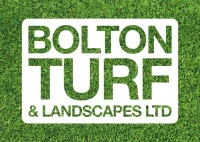Bolton Turf helps homeowners keep their lawns healthy all year round, offering expert support for both turf installations in Milton Keynes and artificial turf installation. This article explains can you mow a wet lawn, providing practical advice for homeowners who want to maintain a beautiful garden.
The temptation to get the mower out after a heavy downpour can be strong, especially when the grass is getting out of hand and the forecast shows more rain to come. But mowing a wet lawn is more than just a mild inconvenience; it can cause lasting damage to both your turf and your tools if not approached carefully. So, the short answer is yes, you can mow a wet lawn, but that doesn’t mean you should.
What Happens When You Mow Wet Grass
When grass is wet, it becomes heavy, slick, and harder to cut cleanly. Instead of standing upright, blades often bend under the weight of water, which leads to uneven trimming. Rather than being sliced cleanly, the grass can tear, leaving ragged tips that are more vulnerable to disease.
Clumping is another issue. Wet clippings tend to clump together, sticking to the mower deck, clogging the blades, and smothering sections of the lawn if left behind. These clumps can block sunlight and trap moisture, creating the perfect conditions for mould or fungal infections to develop. That’s not just unsightly, it can threaten the health of your entire lawn.
The Risk to Your Lawn’s Health
One of the biggest risks of mowing a wet lawn is soil compaction. When the ground is saturated, it’s softer and more vulnerable to pressure. Walking or rolling a mower over it presses the soil down, squeezing out air pockets that are essential for root growth. Over time, compacted soil can suffocate the grass, slow down drainage, and encourage moss and weeds to take over.
Wheel ruts are another concern. Pushing a heavy mower across wet ground can leave deep tracks that ruin the level surface of your lawn. These ruts may need reseeding and levelling later on, which takes time and effort that could have been avoided.
The Toll on Your Mower
Your mower wasn’t designed to operate in swamp-like conditions. Wet grass sticks to the underside of the deck and clogs the blades, reducing cutting efficiency and putting strain on the engine. Over time, this build-up can cause corrosion and mechanical wear, shortening the life of the machine. If you’re using an electric mower, the risks multiply wet conditions can pose safety hazards if moisture seeps into electrical components.
When Mowing Wet Grass Becomes Unavoidable
There are moments when mowing a wet lawn isn’t just an option, it’s a necessity. Maybe you’re dealing with a stretch of poor weather, or your grass is growing faster than expected. In such cases, proceed with caution. Raise the blade height to avoid scalping the grass. Take it slow, and clean the mower frequently during use to prevent clogging. Sharpened blades are crucial to ensure the cleanest cut possible. Once finished, rake up any visible clumps to avoid suffocating the grass beneath.
The Best Approach
Patience is your best tool. If the weather allows, wait until the grass dries out. Early afternoon on a dry, breezy day is ideal, any dew will have lifted, and the grass will be standing upright. This gives you the best chance at a clean, even cut that keeps your lawn healthy and looking sharp. Regular mowing during dry periods also helps avoid the panic that comes when you realise you’ve let things grow too long just as the rain begins to fall.
Grass Type Matters
Some grass species are more resilient to being mown wet. For example, ryegrass tends to handle damp conditions better than fine fescues or bentgrass. Knowing what type of turf you’re dealing with can help inform how cautious you need to be.
Mowing Height Can Save You
Cutting too low when grass is wet amplifies the risk of scalping the lawn. Mowing higher not only protects the crown of each grass blade but also helps maintain healthier roots, especially in stressed conditions like wet weather.
Blades Must Be Razor-Sharp
A dull blade will tear rather than cut wet grass, causing frayed tips that brown quickly and become disease prone. Sharpening your mower blades more frequently during rainy seasons is a small effort that pays off massively in lawn appearance and health.
Clean-Up Isn’t Optional
After mowing in wet conditions, always clean the underside of your mower deck. Not only will this improve performance, but it also prevents fungal spores from spreading if any are present in the grass clippings. Cleaning also prevents rust and deterioration of metal parts.
Consider Using a Mulching Mower
Standard mowers can leave large clumps on the lawn when grass is wet, but mulching mowers are designed to cut clippings more finely. This can reduce the size of clumps, though it’s still best to mow dry if you want optimal mulching performance.
Foot Traffic After Mowing Makes Things Worse
After mowing, avoid walking over the grass any more than necessary. You’ve just stressed the turf with mowing, adding foot traffic compounds the damage, especially if the ground is already soft or muddy.
Final Word
Mowing a wet lawn isn’t just inconvenient, it’s risky for your grass, your equipment, and your lawn’s long-term health. While it can be done in a pinch, the better choice is always to wait for drier conditions. Managing your mowing schedule around the weather is part of smart lawn care. And if you’re investing time into your turf, it’s worth doing it the right way—one dry day at a time.
You may also find when to scarify lawn and how to aerate lawn useful when planning wider lawn improvements. More guidance can be found in Help & Guidance.


